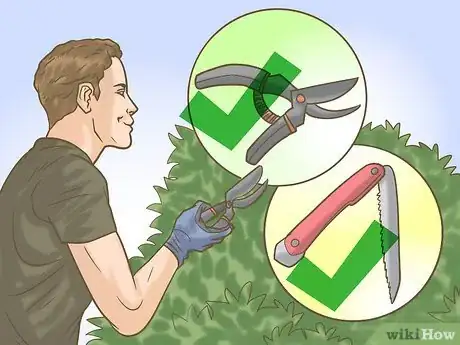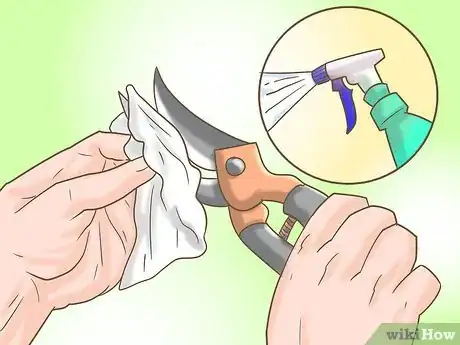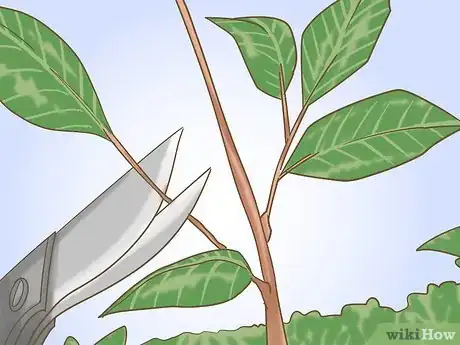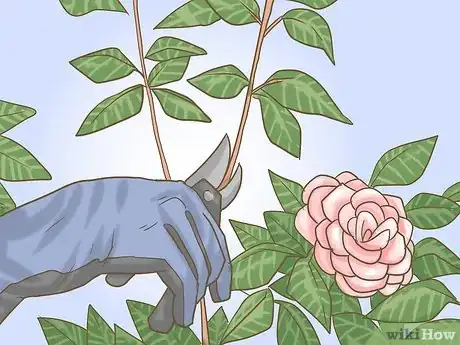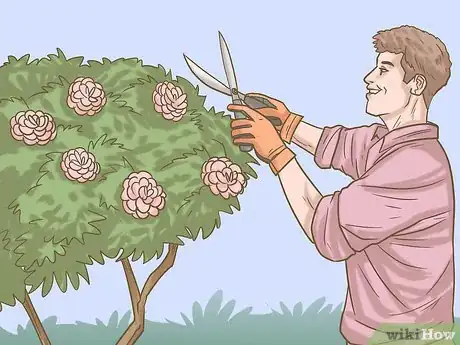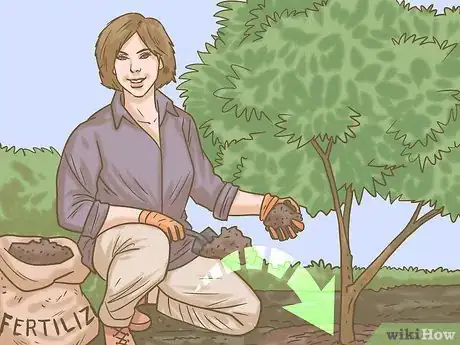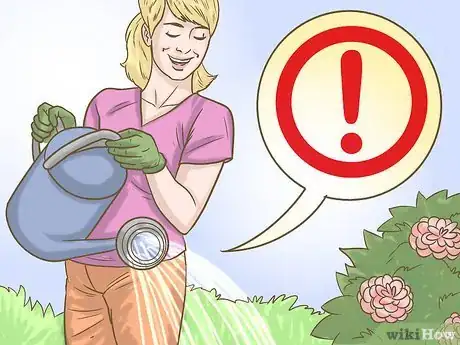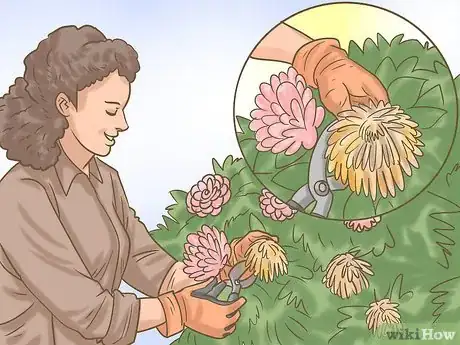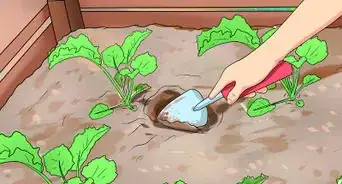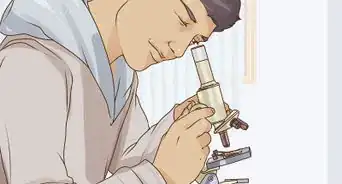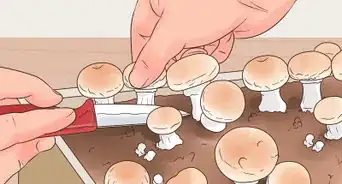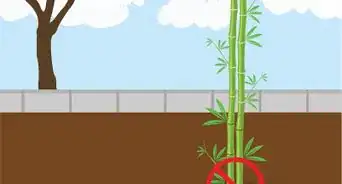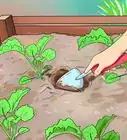This article was co-authored by wikiHow Staff. Our trained team of editors and researchers validate articles for accuracy and comprehensiveness. wikiHow's Content Management Team carefully monitors the work from our editorial staff to ensure that each article is backed by trusted research and meets our high quality standards.
There are 7 references cited in this article, which can be found at the bottom of the page.
This article has been viewed 75,047 times.
Learn more...
Camellia is a very popular plant that can really enhance the look of your garden with its beautiful foliage and magnificent blooms. It is generally easy to care for but knowing know to prune properly will help you cultivate and maintain healthy, vigorous plants that you can enjoy growing to whatever size and shape you want.[1]
Steps
Getting the Timing and Tools Right
-
1Prune immediately after the flowers have finished blooming. This will be before new growth starts and is likely to be in spring. However, as this can differ between varieties be sure to check. Do some online research, ask a knowledgeable friend or enquire at your local gardening center.[2]
- Pruning at other times will not harm the plant but there may be fewer flowers the following year.
-
2Use sharp pruning shears and a pruning saw. Shears are ideal for smaller stems while the saw will be better for larger branches. A sharp cut will heal much more rapidly than a ragged cut made by a blunt tool. Sharp cuts also reduce the likelihood of disease-causing organisms entering through the cuts after pruning.[3]
- The tools you will need are widely available at garden centers.
Advertisement -
3Ensure that all tools are clean to avoid transmitting diseases. Pests and disease can be easily transferred from one plant to another by infected gardening equipment. Remove soil, dirt and other debris from the tools first. Then spray or soak the surface of each tool with disinfectant. Common household disinfectants or liquid bleach can be used for this.[4]
- It is advisable to wear gloves while disinfecting tools, particularly if you have sensitive skin.
Removing Dead and Overgrown Foliage
-
1Make cuts with the blade as close as possible to the remaining branch. Be careful not to damage the bark as you cut. Also try not to damage the raised ridges at the connection points between branches.
- After pruning, the plant will grow new material at these ridges to protect itself from potential diseases being introduced through the cuts.
-
2Thin out the inner leaves and stems to help prevent disease. This improves airflow and allows more light to get to the middle of the plant, controlling pest infestations.[5]
- Make sure that you cut entire branches off at the point where they meet other branches.
- Rather than dumping the pruned material, use it as a mulch for the plants themselves.
-
3Cut the ends of branches after blooming to the size you want to achieve. This will enable you to grow the plant to the size and shape you would like. It will also encourage fuller growth and more flowers.[6]
- To grow a larger plant, prune back to an inch or less.
- To grow a smaller plant, prune back to a few inches less than you want as a final result.
Maintaining Camellia
-
1Fertilize in spring and again in early summer with an acidic fertilizer. Camellias are acid-loving plants so will not do well on highly alkaline soils. Pull back the mulch, spread the fertilizer around the plant and water well to prevent the plant from being burnt. Make sure you follow any other special instructions directed on the label.[7]
- Using controlled-release pellets will mean your plants will not need to be fed until the following year.
- Organic fertilizers based on seaweed, blood and bone can also be used but as these are mildly alkaline care should be taken to use them only on acid soils.
-
2Do not over-water the plants. In general, established plants will not require any watering at all except in prolonged dry conditions. It should be planted in well-drained soil. Camellia does not thrive in the wet and is prone to fungal diseases when exposed to too much moisture.[8]
- Leaf gall, also known as oedema, is a fungal disease of leaves associated with wet conditions.
- Root rot is another fungal disease caused by too much water and eventually results in plant death.
-
3Remove dead flowers. Dying blooms can remain attached to branches for a long time and look unsightly. Removing these dead blooms, termed deadheading, will improve the appearance of the plant and encourage growth of new flowers.[9]
- Deadheading is better carried out by hand rather than with tools. Simply twist the old bloom gently off the stem.
- Petal blight is a fungal disease that causes flowers to turn brown. It is usually associated with too much water in springtime and can be treated with a fungicide.
Expert Q&A
-
QuestionWhat is pruning?
 Monique CapanelliMonique Capanelli is a Plant Specialist and the Owner and Designer for Articulture Designs, an innovative design firm and boutique in Austin, Texas. With over 15 years of experience, Monique specializes in interior botanical design, living walls, event decor, and sustainable landscape design. She attended the University of Texas at Austin. Monique is a Certified Permaculture Designer. She provides plant and botanical design experiences, from small gifts to entire transformations, to shoppers as well as commercial clients including Whole Foods Market and The Four Seasons.
Monique CapanelliMonique Capanelli is a Plant Specialist and the Owner and Designer for Articulture Designs, an innovative design firm and boutique in Austin, Texas. With over 15 years of experience, Monique specializes in interior botanical design, living walls, event decor, and sustainable landscape design. She attended the University of Texas at Austin. Monique is a Certified Permaculture Designer. She provides plant and botanical design experiences, from small gifts to entire transformations, to shoppers as well as commercial clients including Whole Foods Market and The Four Seasons.
Plant Specialist Pruning means removing the dead parts of a plant or tree and cutting the branches to make it shapely.
Pruning means removing the dead parts of a plant or tree and cutting the branches to make it shapely. -
QuestionHow can I encourage fuller growth?
 Monique CapanelliMonique Capanelli is a Plant Specialist and the Owner and Designer for Articulture Designs, an innovative design firm and boutique in Austin, Texas. With over 15 years of experience, Monique specializes in interior botanical design, living walls, event decor, and sustainable landscape design. She attended the University of Texas at Austin. Monique is a Certified Permaculture Designer. She provides plant and botanical design experiences, from small gifts to entire transformations, to shoppers as well as commercial clients including Whole Foods Market and The Four Seasons.
Monique CapanelliMonique Capanelli is a Plant Specialist and the Owner and Designer for Articulture Designs, an innovative design firm and boutique in Austin, Texas. With over 15 years of experience, Monique specializes in interior botanical design, living walls, event decor, and sustainable landscape design. She attended the University of Texas at Austin. Monique is a Certified Permaculture Designer. She provides plant and botanical design experiences, from small gifts to entire transformations, to shoppers as well as commercial clients including Whole Foods Market and The Four Seasons.
Plant Specialist You can prune the trees to encourage them to grow more branches and bear more flowers.
You can prune the trees to encourage them to grow more branches and bear more flowers. -
QuestionHow do I prune a heavy camellia plant that is growing outward for sun?
 NinoxTop AnswererYou can prune it just enough to keep it symmetrical each year. If it becomes too big, you can prune the extra branches.
NinoxTop AnswererYou can prune it just enough to keep it symmetrical each year. If it becomes too big, you can prune the extra branches.
References
- ↑ https://www.americancamellias.com/care-culture-resources/general-culture-requirements/pruning-camellias
- ↑ https://www.gardeningknowhow.com/ornamental/flowers/camellia/pruning-camellias-how-to-prune-a-camellia-plant.htm
- ↑ http://camelliasaustralia.com.au/cultivation/ongoing-care/pruning-camellias/
- ↑ https://extension.psu.edu/disinfecting-tools-equipment-pots-flats-and-benches
- ↑ https://www.gardeningknowhow.com/ornamental/flowers/camellia/pruning-camellias-how-to-prune-a-camellia-plant.htm
- ↑ https://www.gardeningknowhow.com/ornamental/flowers/camellia/pruning-camellias-how-to-prune-a-camellia-plant.htm
- ↑ https://www.rhs.org.uk/advice/profile?PID=327
- ↑ https://www.gardeningknowhow.com/ornamental/flowers/camellia/identifying-and-fixing-problems-with-camellias.htm
- ↑ http://living.thebump.com/should-cut-old-blooms-off-camellias-9845.html
About This Article
Camellia can make a wonderful addition to your garden, and pruning them properly will make sure they stay healthy. Prune your camellia immediately after the flowers have finished blooming in the spring so you don’t affect any new growth. Use sharp pruning shears to remove dead or overgrown foliage as close to the main branch as possible. You should also thin out the inner leaves and stems since this will allow for more airflow. After you’ve thinned the plant, cut the ends of the branches to whatever size you want the plant to be. To learn how to fertilize your Camellia, read on!

